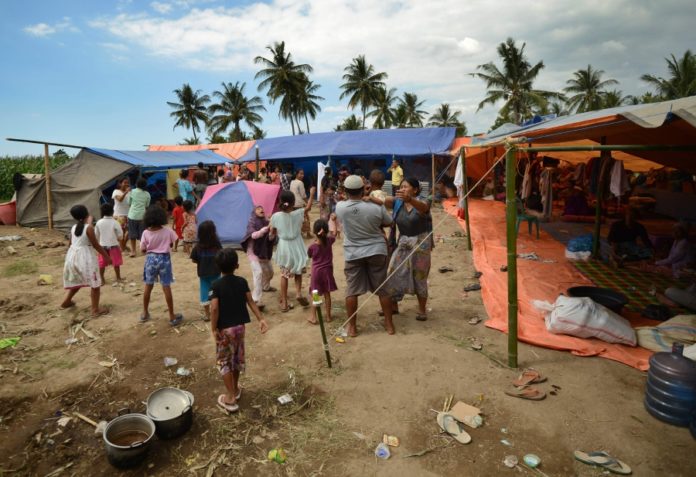MATARAM, Indonesia, Aug 9, 2018 (BSS/AFP) – The death toll from a
devastating earthquake on the Indonesian island of Lombok jumped to 319
Thursday, as strong aftershocks triggered panic among traumatised survivors
waiting for aid in the worst-hit regions.
The shallow 6.9-magnitude quake Sunday levelled tens of thousands of
homes, mosques and businesses across Lombok, with relief agencies only just
starting to reach survivors in some of the worst-hit areas four days later.
“Our latest update is that 319 people died,” said Indonesia’s chief
security minister Wiranto, who like many Indonesians goes by one name, adding
that rescue efforts were ongoing and complicated by aftershocks.
The number forced from their homes in the disaster has soared to 270,000,
national disaster agency spokesman Sutopo Purwo Nugroho said, with around
1,000 people severely injured.
Most of the displaced are sleeping under tents or tarpaulins near their
ruined homes or in evacuation shelters that are short of food, clean water
and medical help.
Makeshift medical facilities have been set up to treat the injured.
Survivors of the quake have also been shaken by hundreds of aftershocks,
including a shallow 5.9-magnitude quake Thursday which caused people to flee
evacuation shelters crying and screaming.
Motorcycles parked on the street in northern Lombok’s Tanjung district
toppled over and the walls of some nearby buildings collapsed.
“We were stuck in the traffic while delivering aid, suddenly it felt like
our car was hit from behind, it was so strong,” witness Sri Laksmi told AFP.
“People in the street began to panic and got out of their cars, they ran
in different directions in the middle of the traffic.”
Twenty-four people were injured by falling debris in the tremor, Nugroho
said.
– ‘Exceptionally destructive’ –
Authorities and international relief groups have begun organising aid, but
badly damaged roads have slowed efforts to reach survivors in the mountainous
north of Lombok, which bore the brunt of the quake.
Aid had begun trickling into some of the most isolated regions by midday
Thursday, officials said, but many displaced people still lack basic
supplies.
In some parts of northern Lombok, survivors can be seen standing on the
road with cardboard boxes asking for donations and food.
“It is already clear that Sunday’s earthquake was exceptionally
destructive,” Christopher Rassi, the head of a Red Cross assessment team on
Lombok, said in a statement.
“I visited villages yesterday that were completely collapsed.”
Workers with heavy machinery are searching the rubble of homes, schools
and mosques, with hope of finding any survivors fading.
There are fears that two collapsed mosques in north Lombok had been filled
with worshippers.
Rescuers have found three bodies and also managed to pull one man alive
from the twisted wreckage of one mosque in Lading Lading village, while at
least one body has been spotted under the rubble in Pemenang.
Authorities are gathering information from family members with missing
relatives to determine how many more people may have been in the buildings
when they collapsed, national search and rescue agency spokesman Yusuf Latif
told AFP.
– Waiting for aid –
Across much of the island, a popular tourist destination, once-bustling
villages have been turned into virtual ghost towns.
Evacuees in some encampments say they are running out of food, while
others are suffering psychological trauma after the powerful quake, which
struck just one week after another tremor surged through the island and
killed 17.
There is a dire need for medical staff and “long-term aid”, especially
food and medicine in the worst-hit areas, government officials said.
About 200 cars packed with food, medicine and basic supplies were sent to
heavily impacted regions in the north and west Thursday morning, Agung
Pramuja, a spokesman for Mataram mitigation disaster agency, told AFP.
But some evacuees have complained of being ignored or experiencing long
delays for supplies to arrive at shelters.
At a shelter in hard-hit Kayangan, new mother Rusnah, who like many
Indonesians goes by one name, said she needed basic supplies for her
children.
“I’m still in pain from giving birth,” she told AFP. “I need diapers, I
need milk.”
Other evacuees said they were subsisting on a diet of instant noodles and
needed clean water and bedding.
The Indonesian Red Cross said it had set up 10 mobile clinics in the north
of the island.
A field hospital has also been established near an evacuation centre
catering to more than 500 people in the village of Tanjung.
Kurniawan Eko Wibowo, a doctor at the field hospital, said most patients
had broken bones and head injuries.
“We lack the infrastructure to perform operations because (they) need to
be performed in a sterile place,” Wibowo told AFP.
Aid groups say children are particularly vulnerable, with many sleeping in
open fields and suffering illnesses from lack of warm clothing and blankets.



